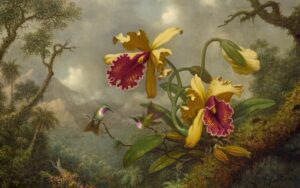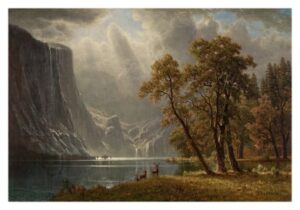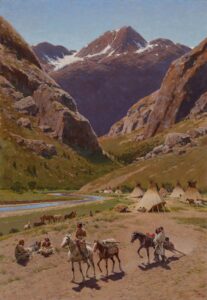
Hummingbirds and Gold and Purple Orchids by Martin Johnson Heade
The New York auction houses recently concluded a week of American art sales, including the American Sublime sale at Christie’s. Sotheby’s also had its own auction the following day called Art of the Americas. The star of the sale, used by Sotheby’s in their promotional material, was Hummingbirds and Gold and Purple Orchids by Martin Johnson Heade. After returning from South America in 1870, Heade embarked on a painting series combining elements of landscape and still life, as well as pulling from illustrations common in natural history books. He tried to depict various examples of native flowers and animals against the lush backdrop of a rainforest. Heade originally intended to create a book of lithographs on Brazilian hummingbirds. However, when this fell, he opted for the series of paintings instead. The titular orchids are cattleya dowiana, considered one of the most prized cultivars of the flower in the nineteenth century. Heade only created three paintings with this specific orchid variety. The painting had been in the same private collection for nearly thirty years before its sale at Sotheby’s — first time it ever crossed the block at auction. With a high pre-sale estimate of $1.8 million, Sotheby’s expected the orchids and hummingbirds to become one of the most valuable Heade paintings ever sold. The results exceeded their expectations, as bidders drove the hammer price beyond the estimate, hammering at $2 million (or $2.08 million w/p). This made it the fourth most valuable work by the artist sold at that auction.

Yosemite by Albert Bierstadt
Next up was Albert Bierstadt’s Yosemite, one of the German-born American artist’s famous Western landscapes. Bierstadt frequently accompanied surveyors and other exploration parties into the West. He would make studies and sketches there, which he would later use as the basis for large landscapes. In 1863, Bierstadt spent seven weeks in the Yosemite Valley, resulting in many paintings, including the one offered at Christie’s on Friday. This is also likely the same trip that resulted in his monumental 1868 landscape Among the Sierra Nevada, now at the Smithsonian American Art Museum. The Yosemite painting is a more manageable size, about 20 by 30 inches, and is likely one of the earlier paintings finished after returning from the West. Predicted to sell for between $700K and $1 million, Yosemite by Albert Bierstadt sold slightly below estimate at $650K (or $780K w/p). Also selling for the same hammer price was Henry François Farny’s The Happy Days of Long Ago. The 1912 painting shows an indigenous settlement in the West: a collection of teepees clustered together beside a riverbank in the background while a mother, father, and child seem to be packing up and moving out. It’s meant to be somewhat of an allegory about a balanced relationship between nature and humanity. The painting was originally owned by a family in Cincinnati before donating it to the Cincinnati Art Museum in 1955. Later, in the 1980s, it found its way into the collection of renowned test pilot Darryl Greenamyer, who decided to loan it to the White House between 1981 and 1986. Though the Farny sold for the same as the Bierstadt, unlike Yosemite, it sold within its pre-sale estimate range, which was $500K to $700K.

The Happy Days of Long Ago by Henry François Farny
The Sotheby’s Art of the Americas sale contained its fair share of surprises, with five of the ninety-three available lots selling for more than double their high estimates. The most notable of these surprises was a pair of Mexican oil paintings showing scenes of rural life. One is called Seis jinetes lanzando toro (Six horsemen pursuing a bull), while the other is titled El ganado (The Livestock), showing a cattle drive. Both paintings are by Ernesto Icaza, a Mexican painter and horseman, depicting scenes of ranch life in Mexico in the late nineteenth and early twentieth centuries. Sotheby’s only expected the paintings to sell for no more than $15K. However, interest was greater than anticipated, resulting in the duo selling for $65K (or $78K w/p), about 4.3 times the high estimate. Similarly, there was Still Life with Fish by William Merritt Chase. The jet-black background seems unusual for a nineteenth-century American still-life painting. It looks like someone tried to emulate the chiaroscuro of Caravaggio. Predicted to sell for $8K at the most, the fishy painting hammered at $32K (or $38.4K w/p), exactly four times the high estimate.
Of the ninety-three available lots, twenty-five sold within their estimates, giving Sotheby’s a 27% accuracy rate. An additional thirty-six lots (39%) sold below estimate, while twenty (22%) sold above. This left twelve lots unsold, resulting in an 87% sell-through rate. Against a total low estimate of $6.8 million, Sotheby’s brought in $7.5 million hammer, or $8.7 million w/p.
Sotheby’s Art Of The Americas
Hummingbirds and Gold and Purple Orchids by Martin Johnson Heade
The New York auction houses recently concluded a week of American art sales, including the American Sublime sale at Christie’s. Sotheby’s also had its own auction the following day called Art of the Americas. The star of the sale, used by Sotheby’s in their promotional material, was Hummingbirds and Gold and Purple Orchids by Martin Johnson Heade. After returning from South America in 1870, Heade embarked on a painting series combining elements of landscape and still life, as well as pulling from illustrations common in natural history books. He tried to depict various examples of native flowers and animals against the lush backdrop of a rainforest. Heade originally intended to create a book of lithographs on Brazilian hummingbirds. However, when this fell, he opted for the series of paintings instead. The titular orchids are cattleya dowiana, considered one of the most prized cultivars of the flower in the nineteenth century. Heade only created three paintings with this specific orchid variety. The painting had been in the same private collection for nearly thirty years before its sale at Sotheby’s — first time it ever crossed the block at auction. With a high pre-sale estimate of $1.8 million, Sotheby’s expected the orchids and hummingbirds to become one of the most valuable Heade paintings ever sold. The results exceeded their expectations, as bidders drove the hammer price beyond the estimate, hammering at $2 million (or $2.08 million w/p). This made it the fourth most valuable work by the artist sold at that auction.
Yosemite by Albert Bierstadt
Next up was Albert Bierstadt’s Yosemite, one of the German-born American artist’s famous Western landscapes. Bierstadt frequently accompanied surveyors and other exploration parties into the West. He would make studies and sketches there, which he would later use as the basis for large landscapes. In 1863, Bierstadt spent seven weeks in the Yosemite Valley, resulting in many paintings, including the one offered at Christie’s on Friday. This is also likely the same trip that resulted in his monumental 1868 landscape Among the Sierra Nevada, now at the Smithsonian American Art Museum. The Yosemite painting is a more manageable size, about 20 by 30 inches, and is likely one of the earlier paintings finished after returning from the West. Predicted to sell for between $700K and $1 million, Yosemite by Albert Bierstadt sold slightly below estimate at $650K (or $780K w/p). Also selling for the same hammer price was Henry François Farny’s The Happy Days of Long Ago. The 1912 painting shows an indigenous settlement in the West: a collection of teepees clustered together beside a riverbank in the background while a mother, father, and child seem to be packing up and moving out. It’s meant to be somewhat of an allegory about a balanced relationship between nature and humanity. The painting was originally owned by a family in Cincinnati before donating it to the Cincinnati Art Museum in 1955. Later, in the 1980s, it found its way into the collection of renowned test pilot Darryl Greenamyer, who decided to loan it to the White House between 1981 and 1986. Though the Farny sold for the same as the Bierstadt, unlike Yosemite, it sold within its pre-sale estimate range, which was $500K to $700K.
The Happy Days of Long Ago by Henry François Farny
The Sotheby’s Art of the Americas sale contained its fair share of surprises, with five of the ninety-three available lots selling for more than double their high estimates. The most notable of these surprises was a pair of Mexican oil paintings showing scenes of rural life. One is called Seis jinetes lanzando toro (Six horsemen pursuing a bull), while the other is titled El ganado (The Livestock), showing a cattle drive. Both paintings are by Ernesto Icaza, a Mexican painter and horseman, depicting scenes of ranch life in Mexico in the late nineteenth and early twentieth centuries. Sotheby’s only expected the paintings to sell for no more than $15K. However, interest was greater than anticipated, resulting in the duo selling for $65K (or $78K w/p), about 4.3 times the high estimate. Similarly, there was Still Life with Fish by William Merritt Chase. The jet-black background seems unusual for a nineteenth-century American still-life painting. It looks like someone tried to emulate the chiaroscuro of Caravaggio. Predicted to sell for $8K at the most, the fishy painting hammered at $32K (or $38.4K w/p), exactly four times the high estimate.
Of the ninety-three available lots, twenty-five sold within their estimates, giving Sotheby’s a 27% accuracy rate. An additional thirty-six lots (39%) sold below estimate, while twenty (22%) sold above. This left twelve lots unsold, resulting in an 87% sell-through rate. Against a total low estimate of $6.8 million, Sotheby’s brought in $7.5 million hammer, or $8.7 million w/p.